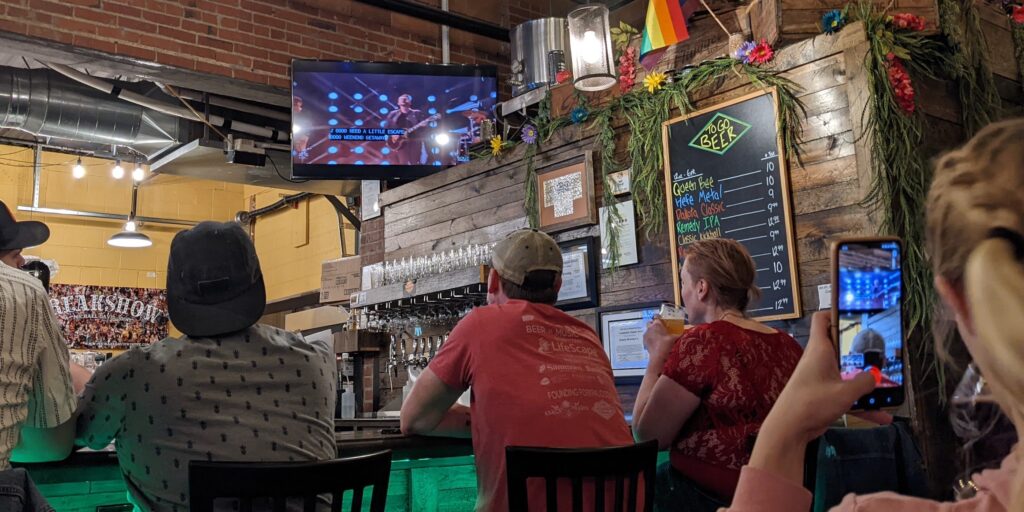At 95, state’s longest operating photographer serves as living historian
Put the words “Bill Pay” in an internet search engine, and you’ll likely be directed to your local utilities’ website, eager to collect what it’s owed.
That’s why at the age of 95 Pay has renamed himself. He now introduces himself as “William Pay” to reduce the confusion should anyone want to know more about him. Or hire him.
And they — you — should. Particularly if you are from Sioux Falls or live here now. Particularly if you relish learning city history. Particularly if you’ve admired the aerial photos of Sioux Falls that are on display around the community.

If you’ve seen the black-and-white photo of the historic Queen Bee Mill going up in flames, that was Pay’s work. The 70-year-old photo of downtown Sioux Falls with a Chamber of Commerce sign proudly welcoming visitors to the city of 60,000? That was taken by Pay too. If you wanted a photograph of how your business’ building looked decades ago, you contacted Bill Pay, and chances were good he had it in his files.

“I got a call just before you got here, and I’m going to go see him Monday morning 10 o’clock about a picture he’s interested in of his bank,” Pay said to start a recent interview. “I took it downtown in 1957.”
Yes, 1957. By then, 55 years ago, Pay already had 15 years’ experience taking photographs. He had begun shooting photos professionally at the age of 15, after a job frying doughnuts for a Sioux Falls bakery proved to be a disappointment.

A friend told him photographer Emil Hanson, who had a studio at 122 1/2 S. Phillips Ave., needed what Pay describes as an errand boy. That was during World War II when Sioux Falls hosted an air base, crowded with servicemen eager to send portraits in uniform home to parents and sweethearts.
“My job was to package them up and mail them all over the United States,” Pay said.
His duties expanded quickly. Hanson had a contract with the Argus Leader newspaper — desperate for photographers during the war years — to take photos. Hanson started sending Pay, who had owned a Univex brand camera for several years, out on assignments. Even if it was for something as insubstantial as society news, Washington High School principals would let Pay leave class to help Hanson.

His first photo published in the newspaper definitely fell in the category of hard news. And Pay happened to be in the right place at the right time.
“I was doing something downtown, and I heard a large explosion. About three blocks away, a guy was welding a gasoline tank,” he said. “You’re supposed to fill them full of water so there’s no air in it. He didn’t do that. It killed him and blew out the walls. I just happened to be there. That was the first picture I made of news-news.”
That’s just one of a wealth of stories Pay can tell. His friends savor time spent with him when he may talk about his family, which has spent more than 130 years in Sioux Falls. In fact, Lake Byron in Beadle County is named after Pay’s great-uncle Byron Pay, who stayed there in the 1860s. Byron Pay was a Medal of Honor recipient for his valor during the Civil War, said Pay’s longtime friend Dave Lewis. Several years ago when the state of Minnesota honored its Medal of Honor recipients, Byron Pay was included as a resident. He technically had been a Minnesotan when it included the future South Dakota during its years as a territory. His old friend attended the ceremony and learned something new about his family, Lewis said.
“Bill stood up as a relative, and two gals also got up, and they were cousins of Bill that he never knew existed,” Lewis said. “But imagine having a great-uncle who was in the Civil War. And his great-nephew is still here.”
The Pay family sacrificed for this country again during World War II when Pay’s brother Asher died March 10, 1945, during the Battle of Remagen, Lewis said.
Lewis thinks he has known Pay since the 1950s when his mother would take film to be developed at Pay’s store in the Southway Shopping Center on South Minnesota Avenue. Lewis tells stories that Pay himself hasn’t shared, such as traveling to New York City with his father on a buying trip for the Pay family gift shop.
Since they were there, Pay’s father proposed, they should go to a New York Yankees baseball game. They were sitting in the stands when someone started speaking into a microphone set up at home plate.
“It was the famous Lou Gehrig farewell speech,” Lewis said, referring to the noted ballplayer’s “luckiest man on the face of the earth” speech when a neurological illness forced his retirement. “A couple million people have probably said they were there, but he was one of the 60,000, 70,000 people who actually were there.”

That’s an example of what gives his friend a unique status, Lewis said. Pay’s connections stretch back more than 160 years, and he continues to impact the present with his photographs.
Pay recognizes the place he holds.
“In my mind at least, I’m the oldest and longest continuing operating photographer in South Dakota,” he said. “Probably in Iowa, Minnesota and who knows where.”
Pay graduated from Washington in 1945 and the University of South Dakota in 1949. In the summers, he worked for Harold and Howard Hanson, Emil’s sons who had started a portrait studio.

Pay knew that was not what he wanted. While he has made portraits of multiple famous people over the years — he can shake images of former first lady Laura Bush, ballplayers Billy Martin and Harmon Killebrew, quarterback Brett Favre and many others from their storage space in a manila envelope — he had his sights set on images of brick and mortar, from the street and from the sky.
Especially shooting them from the sky as often as possible, long before cameras could be attached to drones. Pay became known for his aerial views of Sioux Falls and other locations, recording the city as it changed from one bridge over the Big Sioux River to multiple, as the railyards contracted to just a few tracks, as the stockyards disappeared.
The rapidity of Sioux Falls’ growth and change still amazes Pay.
“Oh, boy, change — in six months or six weeks,” Pay said. “Go for a ride now, come back in two weeks, there’s a whole string of apartment houses up.”
Sioux Falls always has been a city of rapid change, Pay said. Often, his family was part of it. Pay’s grandfather operated a vaudeville theater downtown, and he recognized early on when it was time to change over to moving pictures.
Pay himself frequently has adapted to change. He opened Bill Pay’s Photography in 1957, selling photographic equipment and offering photofinishing and commercial photography. In 1973, he closed everything but the commercial photography.

Lewis met Pay in the late 1950s when he would accompany his mother to the Minnesota Avenue store when she dropped off film to be developed or picked it up. As adults, the two men participated in Shriners activities together. Today, they meet every Monday afternoon with a couple of other friends when Pay opts for his favorite, Grain Belt beer.
Carole Ryden and Pay have been friends since 2013, although the family connection goes back decades. She met Pay through her brother, Mark Smith, a longtime pal. Ryden’s father, David Smith, worked for the Argus Leader, one of the reporters who could summon Pay from class.
Ryden admires Pay for his love of life.
“He’s just very dynamic. He loves people; he’s very social. And he loves photography, talking about it or doing it,” said Ryden of Luverne, Minnesota. “He loves history, especially the history of Sioux Falls where he grew up. He’s just a fixture of Sioux Falls. He can’t go anywhere without people saying, ‘Hi, Bill, how’s it going.’”
Pay has other admirers too.
“Charles Barkley, I took his picture one time,” Pay said of the retired NBA player. “He said: ‘I like that camera guy. He doesn’t fool around.’”
That’s because Pay trusts his instincts when taking photographs. He doesn’t own a digital camera and doesn’t intend to. He displays a mild exasperation with those who use them to take dozens of the same shot. That’s not his style. If he takes your photo, he knows when it’s developed he’ll see the exact image he wanted.
At the most, Pay said, he has used two commercial cameras over 80 years. He estimates the age of his current camera at a quarter century. What’s difficult is finding film and places that still develop it.
“I have one made in 1945 that still works, but I can’t get film for it,” Pay said.
For years, he served as a wedding photographer on Valentine’s Day. Joining a justice of the peace in a nearby hotel lobby, Pay would photograph the nuptials of eight or 10 couples. He also helped at less joyful events.
“I took pictures for eight years for the county coroner’s office,” Pay said. “I’d get called at 2 o’clock in the morning for some car that had rolled over with three people dead.”
People may not realize that Pay took the photographs on their office walls, Lewis said. If they are longtime residents, they may be unaware Pay has connected with their families.
“He knows the history of Sioux Falls through friends of his, through his parents’ friends,” Lewis said. “He knew my parents very well. He knows the children of his friends and their grandchildren. He really has the history of this place.”
History only lasts if people preserve photographs and writings, however. Pay is one of a small handful of male graduates of Washington’s Class of 1945 still living. That includes retired attorney Dean Rallis, former Canaries player Bill Toft,and Dr. Malcolm Jameson, now of Yankton. Does the name Jameson sound familiar? Yes, Pay is quick to tell you, he’s the son and grandson of the former wardens at the South Dakota State Penitentiary. Jameson Annex is named after Malcolm Jameson’s father, warden for 25 years.
“How would you know that from anybody else?” Lewis marveled. “That tells you how his mind is clicking.”
But, wait, there’s more.
“Some guy’s making a documentary, a guy named Lee, about a jailbreak in 1920 where they used the warden as hostage,” Pay said. “The guy making the documentary called me. He wanted to know if I had any pictures. I called Malcolm and said a guy named Lee’s going to call you.”
Now that is the Pay connection.
Pay was the only civilian allowed to take pictures at the Pathfinder Atomic Power Plant that stood briefly northeast of Sioux Falls. He photographed the airport control tower when it stood just two stories tall and equipment consisted of a few simple screens.

His collection includes photos of future President Richard Nixon with then-Sioux Falls Mayor Fay Wheeldon, Gov. Joe Foss and U.S. Sen. Karl Mundt. When looking at a street scene, Pay can tell you what stands there now and what businesses preceded it. He has photographed floods; he has photographed fires.
An hour in his company, and you want to keep him safe behind a velvet rope. Pay would have none of that, however. There are friends to gather with and photo assignments that need time to prepare.
While Pay’s memories can’t be preserved in their entirety, he has taken steps to make sure his photographs and the negatives — every picture he made over an 80-year-and-counting career — will be saved, though he said he can’t share the arrangement’s details at this time.
Until then, if there’s a historic photo you need, call Pay at 605-362-4134. He can have a print made for you — with history thrown in as a bonus.
Share This Story
Most Recent
Videos
Want to stay connected to where you live with more stories like this?
Adopt a free virtual “pigeon” to deliver news that will matter to you.





























